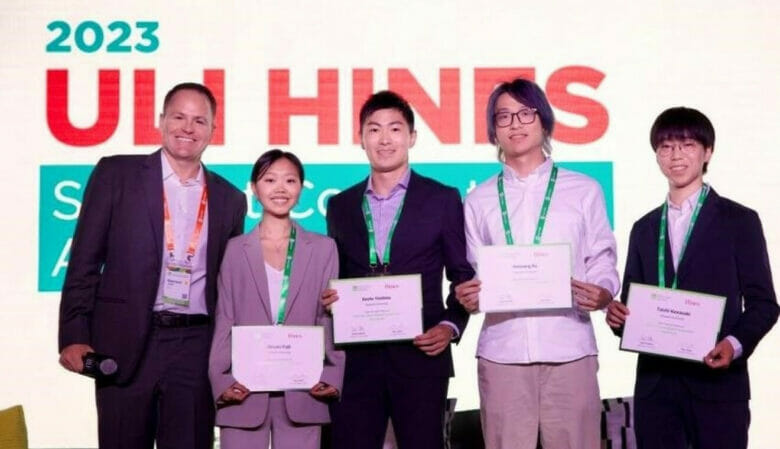
Waseda University students with Ray Lawler (Source: Hines)
A group of university students from Japan won the first-ever Urban Land Institute (ULI) Hines Student Competition in Asia Pacific this past week with their proposal to implement an urban healthy living concept to transform Singapore’s Jurong Lake District (JLD).
During the ULI APAC Summit 2023 this week, the ULI and Hines awarded the top prize in the contest to the Jurong Urban Health Campus plan, with the proposal by a team from Tokyo’s Waseda University, besting 18 entries from students at 14 universities across the region.
“The quality of the proposals were quite high, particularly for an inaugural year,” Hines APAC chief executive officer Ray Lawler told Mingtiandi in an interview on the sidelines of the conference. “Bringing the best group of students into the competition, giving them a real world sight with real world challenges and opportunities are really key to the competition.”
Begun in the US two decades ago and recently introduced in Europe, the competition aims to raise interest in urban development and redevelopment among university students.
Points for Balance
First launched in 2003, the program in the US served as a blueprint for expanding the competition into Europe in 2020 and into APAC this year.

Hines Asia Pacific CEO Ray Lawler
With Jurong Lake District planned to become Singapore’s second central business district, Lawler explained that a jury of six industry experts assessed the proposals based on their design, financial feasibility, attainability and sustainability.
Hines’ APAC chief said the three finalists, including contenders from Vietnam and South Korea, all submitted attractive proposals but the plan from Kento Yoshino, Taichi Kawasaki, Haoyang Xu and Misato Fujii of Waseda University focused on health and education, while providing for a liveable and connected environment that utilises spaces in a multifunctional way.
“The quality of their proposal, the thoughtfulness around the design, the financial feasibility and the balance, taking in mind what the community and government needed, were why they won. The team was well-versed, articulate, smart, thoughtful, deliberate, and took a balanced approach,” Lawler said.
“We really tried to develop a unique concept that would stand out — that was the educational and the urban health for animals, plants, and humans. I think having that kind of concept to root the rest of our design was really strong,” Fuji said in an interview that same day.
The winning proposal features neighbourhoods surrounded with community-centric amenities and green spaces that are accessible within 10 minutes by foot, cycling or public transport.
Next Generation
Yvonne Lim, group director of physical planning at the Urban Redevelopment Authority of Singapore, lauded the Waseda team for creating a heritage place for learning and innovation, while also opening up the waterfront to the public.
“The team made efforts to embody the goals for Jurong Lake District in their plans through their provision of mixed-use developments, sustainable and car-lite features and public open and green spaces,” she said.
Located in the western portion of the city-state, Jurong Lake District spans 360 hectares (890 acres) of land with the government planning to develop Singapore’s largest mixed-use business district outside the city centre as part of ongoing decentralisation efforts.
Lawler and Lim were among the judges in the APAC competition, joined by Peter Hyland, a director with Aussie urban planning outfit Urbis; Choon-Fah Ong of Singapore property consultancy Edmund Tie Holdings, Xiaomei Lee, regional managing principal for Greater China with design firm Gensler; and Dzung Nguyen, co-founder and chief executive officer of urban planning and design consultancy enCity.
Lawler highlighted the importance of the annual competition for supporting and inspiring the next generation of leaders in creating more liveable and sustainable major communities.
“The students today had an extreme focus on sustainability and you have to balance the need for sustainability with the feasibility of actually being able to do the project. It was really nice to see the enthusiasm around the built environment, place-making, live-work–play, transit and sustainability,” he said.
Leave a Reply